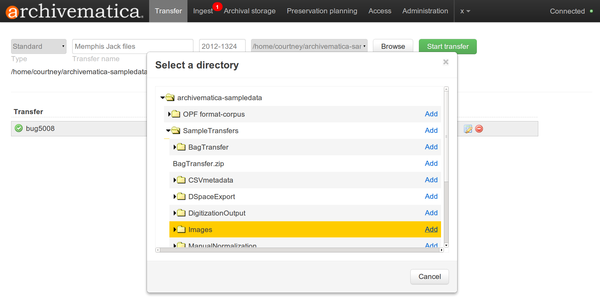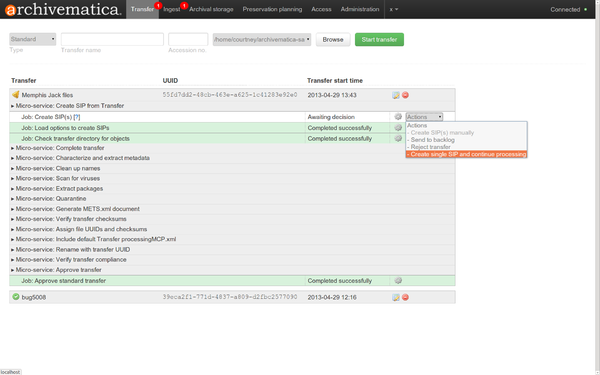UM transfer
Main Page > Documentation > User manual > User manual 0.10 > Transfer
General description
In Archivematica, Transfer is the process of transforming any set of digital objects and/or directories into a SIP. Transformation may include appraisal, arrangement, description and identification of donor restricted, private or confidential contents.
In the Transfer tab of the Dashboard, the user moves digital objects from source directories accessible via the MCP server into Archivematica. See Administrator manual for instructions on how to set up shared source directories. Once uploaded to the dashboard, transfers run through several micro-services: UUID assignment; checksum verification (if checksums are present); package extraction (i.e. unzipping of zipped or otherwise packaged files); virus checking; indexing; format identification and validation; and metadata extraction.
At the end of transfer, the user creates a SIP from one or more standard transfer(s). Once this is done, the SIP is moved into ingest.
If you would like to import lower-level metadata with your transfer (i.e. metadata to be attached to subdirectories and files within a SIP), see Metadata import
If your transfer is a DSpace export, please see DSpace export.
If your transfer is a bag or a zipped bag, please see Bags
If your transfer is an email transfer, this feature is still under development, please see Email
If your transfer is composed of objects that are the result of digitization, please see Digitization output.
Create a transfer
Open the web browser and the Archivematica dashboard to sign in with your username and password. Please note that if this is your first time logging in to a newly installed instance of Archivematica 0.10-beta, you will see a log-in that allows you to register your repository and get updates to the Format Policy Registry (FPR)
- Set up your transfer source directories in the Administration tab. See Administrator manual for instructions on how to set up source directories.
- In transfer tab, name your transfer and browse to a source directory to select your object or set of objects for upload. Your transfer can be composed of multiple directories from different sources. Repeat this step if your transfer is composed from multiple sources. (figure 1)
- If applicable, enter the accession number for the transfer.
- Once all of your digital object sources have been uploaded, hit the Start Transfer button for the transfer processing to begin. (figure 2)
Process the transfer
- In the dashboard transfer tab, the transfer will appear in the dashboard with a bell icon next to it. This means that it is awaiting a decision by the user. (figure 3)
- Click on the micro-service to display jobs that have completed, including the one requiring action.
- In the Actions drop-down menu, select "Approve transfer" to begin processing the transfer (figure 3). You may also "Reject transfer" and quit processing.
- The transfer will now run through a series of micro-services. These include:
- Verify transfer compliance (verifies that the transfer is properly structured - i.e. with the logs, metadata and objects folders)
- Create transfer UUID (assigns a unique universal identifier for the transfer as a whole)
- Assign file UUIDs to objects (assigns a unique universal identifier to each file in the /objects directory)
- Verify metadata directory checksums (verifies any checksums included with the transfer)
- Assign checksums to objects (assigns a sha-256 checksum to each file in the /objects directory)
- Generate METS.xml document (creates a METS file capturing the original order of the transfer. This METS file is added to any SIPs generated from this transfer)
- Extract packages (extracts contents from zipped or otherwise packaged files)
- Sanitize object's file and directory names (removes prohibited characters from folder and filenames, such as ampersands)
- Scan for viruses (scans for viruses and malware)
- Characterize and extract metadata (identifies and validates file formats; extracts technical metadata embedded in the files)
- Index transfer (Indexes transfer)
- A transfer that is in the middle of processing will show which micro-services have been completed (green) and which are in progress (orange).
- When a micro-service fails or encounters an error, the micro-service background turns from green to pink and a "failed" icon appears next to the transfer or SIP name. See Error handling for more information about how to handle an error.
- Once the transfer micro-services are completed, a bell icon will appear next to the transfer. This means that the transfer is ready to be packaged into a SIP for ingest or sent to a backlog, indexed and stored to be retrieved for processing at a later date(figure 4).
- Option 1: Select "Create single SIP and continue processing". (Note that Create SIP(s) manually is not currently functional. However, the ability to create one or more SIP(s) from one or more transfer(s) will return in Archivematica 1.0 with improved functionality in the web browser. See [File_Browser_Requirements|File browser requirements - Create SIP] and [Transfer_and_SIP_creation|Transfer and SIP creation workflows)
- Option 2: Select "Send transfer to backlog". In this case, your transfer will be stored in a backlog in the same location as your AIP store so that you can retrieve one or more transfers from the Ingest tab for processing at a later date. See Managing a backlog
- See Ingest for next steps.



